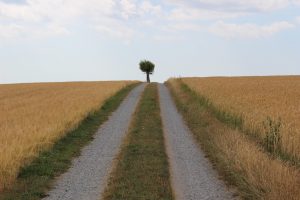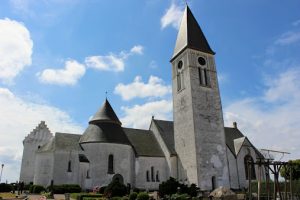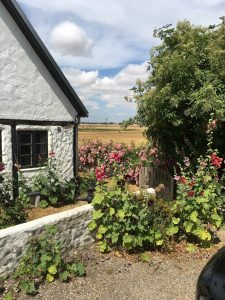 Its been an exceptionally hot, dry summer in Europe this year. Fabulous for us and our tent, but not so fabulous for the farmers.
Its been an exceptionally hot, dry summer in Europe this year. Fabulous for us and our tent, but not so fabulous for the farmers.
I was born in one of the driest states in the world, where we grew up with summer hose-pipe bans, water shortages and droughts, as a matter of course. We had two-minute showers and recycled the washing-up water to save the lawn from burning to a crisp. Bushfires were a constant threat throughout the summer, but on the other hand, you could rely on good weather for a picnic or a party.
I never expected to visit Scandinavia and find a similar scenario.
Two weeks camping in Norway, and the nights were cold, but the days were hot. With the temperature gauge stuck at about 30 degrees centigrade, we headed south to Skåne, and a friend’s farm near Ystad. There, we were gobsmacked to see a landscape that reminded us so clearly of a South Australian summer: parched and yellow, dry as dust under wide blue skies. We were warned that a typical Scandinavian summer might be damp and dreary in a tent. Luckily for us, the only rain we saw was a ten-minute shower in Oslo, from our hotel window.
I Googled Top 10 things to do in Skåne, and I can only suggest you do the same. We did none of them. We were well off the beaten track, where the scenery was rural, the villages cosy and pretty, and tourists were rare. Here, we were closer to Copenhagen than Stockholm, in a landscape surprisingly flat, after Norway’s dramatic and rugged terrain. Here wide sheets of blue sky lay before us, stretched tightly over a mattress of yellow corn and wheat. Instead of the tall, lean French poplars, farmhouses were announced by lines of pollarded willows that looked like green lollipops.
Closer to the coast, a thick band of forest separated the shore line from the farm land, and once we reached the beach, we found squeaky white sand and dunes decorated in a spiky, spinifex-style grass. It was pure South Australia. The beach is regularly bludgeoned by wind and sea, so, perhaps not surprisingly, we were dodging scattered driftwood and gnarly old tree trunks, roots attached, like petrified octopi. The sand was also thickly coated  with bathers, some clad, some not. Yet barely two hundred metres from the car park the beach is empty of any bodies but ours.
with bathers, some clad, some not. Yet barely two hundred metres from the car park the beach is empty of any bodies but ours.
During this mild and gentle summer, the coast was calm and peaceful. Children danced among the waves, or built castles in the sand. But don’t be fooled by its benign appearance: it is a pernicious sea, that hides rip tides, dangerous currents, and shipwrecks galore. In many places, the beach had been torn away to reappear further down the coast, and cliffs had collapsed under the barrage of raging wintry waves, leaving houses perched precariously close to the edge.
Ancient standing stones overlooked the sea, a mini Stonehenge, while other signs of pagan times included a summer solstice maypole, or midsommarstången. As a pagan symbol of fertility, its tall central pole with two round hoops at the top certainly send the right message.
We explored several small seaside villages, looking almost English with their homely, white-washed or brightly coloured cottages, but the cobbled streets are wider here, the red roofs lower. Then, getting peckish, we indulged in a mixed seafood platter by the port, sampling local specialities such as smoked eel and smoked mussels, gravadlax, pickled herring and smoked mackerel accompanied by cold beer.
Back inland, attractive village churches stood out on the skyline, their steeples or stepped roofs rising high above the crops. Mostly whitewashed, they showed off a variety of architectural eras, from the Romans to the nineteenth century. We wandered among gravestones kept beautifully neat and trim, admired the simple decor within.
As we drove down empty country lanes, wildflowers ran amok through the wheat and barley, and along the verges: poppies, red and orange; dainty white daisies; splashes of purple and yellow; feathery grasses. As a rainbow put in a brief appearance, I stood in the middle of the road, imbibed with the still calm of the late afternoon. From here, fields of grain stretched as far as the eye could see, the evening light something I cannot begin to describe, but Monet would have adored, in this Provence of the north.
 We drove past thatched cottages trimmed in blue paint and hollyhocks in a mad swirl of colours. Half-timbered red brick houses leaned at odd angles, fighting gravity more picturesquely than I ever will. Old windmills, their blades removed, had been converted into houses shaped like bee hives. In a huge, red brick barn behind the house dwelt antiquated farm equipment and nesting swallows.
We drove past thatched cottages trimmed in blue paint and hollyhocks in a mad swirl of colours. Half-timbered red brick houses leaned at odd angles, fighting gravity more picturesquely than I ever will. Old windmills, their blades removed, had been converted into houses shaped like bee hives. In a huge, red brick barn behind the house dwelt antiquated farm equipment and nesting swallows.
Gathering with friends in the garden, we sipped on local beer, Luxembourg crémant, chilled Chardonnay – a perfect accompaniment to boiled potatoes and salmon with a mustard and dill sauce – as the evening light drifted on and on… until, at last, an awe-inspiring sunset painted the clouds in dusky pink and wisteria purple. Beside the driveway, half a dozen cherry trees are thick with fruit and flocks of revelling birds. The lawn, burnt to a straw-yellow, prickled the soles of our feet, as we finally headed to bed.
Sadly, since we left, bushfires have been raging in Swedish forests. Seriously, were we in southern Sweden or South Australia?
